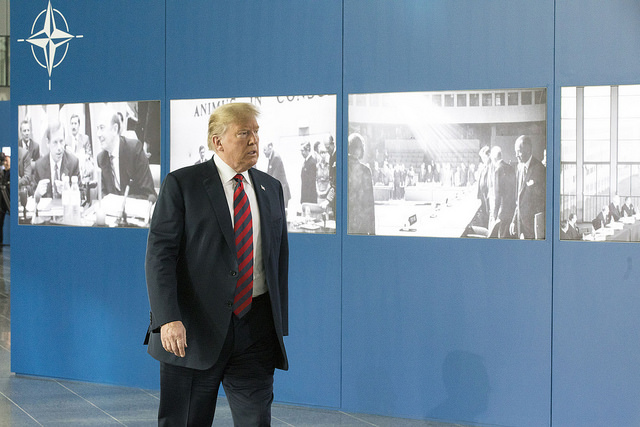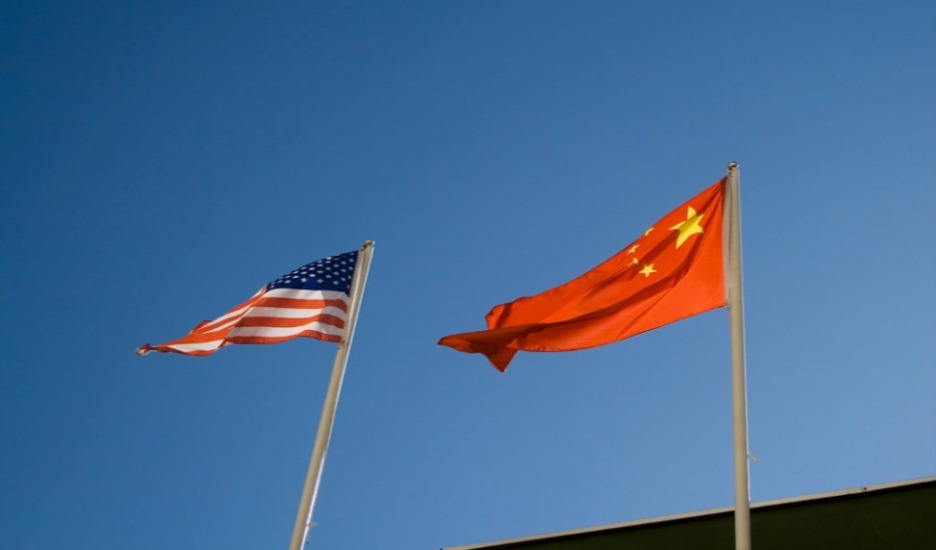Constitutional Issues Relating to the NATO Support Act
President Trump is making noises again about withdrawing the United States from the North Atlantic Treaty, which established NATO. Last week the House of Representatives voted 357-22 in support of the NATO Support Act. The bill does three things.

Published by The Lawfare Institute
in Cooperation With

President Trump is making noises again about withdrawing the United States from the North Atlantic Treaty, which established NATO. Last week the House of Representatives voted 357-22 in support of the NATO Support Act. The bill does three things. First, it states the “sense of Congress” that the president “shall not withdraw the United States from NATO,” and that “the case Goldwater v. Carter is not controlling legal precedent.” Second, it states that “the policy of the United States” is to remain in NATO, to reject efforts to withdraw from NATO, and to work with and support NATO. Third, and most importantly, it prohibits funds “to be appropriated, obligated, or expended to take any action to withdraw the United States from the North Atlantic Treaty.”
These provisions together appear to be designed to prohibit the president from withdrawing from the North Atlantic Treaty. Whether they accomplish this goal is unclear. The language of the act passed by the House could surely be strengthened to make the prohibition on presidential withdrawal clearer and more direct. For example, it could follow the unpassed Senate version (S.J. Res. 4) and add an explicit statement—untied to spending restrictions or to actions that might implicate the president’s power over diplomacy—that the president “shall not suspend, terminate, or withdraw the United States from the North Atlantic Treaty … except” with two-thirds Senate approval or an act of Congress. Our concern here is with the constitutional question of whether a properly drafted statute could restrict the president’s power to withdraw. For this analysis we will therefore assume that the NATO Support Act prohibits the president from withdrawing from the treaty, although we lift this assumption at the end when considering whether courts could adjudicate such a withdrawal.
With this caveat, we reach two conclusions. First, Trump has the constitutional authority to withdraw from the North Atlantic Treaty in accordance with its terms and in the face of congressional silence. Second, his authority to do so would be much less certain if Congress were to bar such withdrawal, whether in the NATO Support Act or other legislation.
A. Background: Presidential Power to Withdraw From Treaties
The United States ratified the North Atlantic Treaty in 1949 after the Senate gave its consent. Under Article 5 of the Treaty, the parties (currently 29 countries) have famously agreed that an armed attack on any of them in Europe or North America “shall be considered an attack against them all” and that if such an attack occurs, each of them “will assist the Party or Parties so attacked by taking forthwith, individually and in concert with the other Parties, such action as it deems necessary, including the use of armed force, to restore and maintain the security of the North Atlantic area.” The Treaty further provides in Article 13 that any party may withdraw from the agreement one year after depositing a notice of denunciation. (An indication that NATO’s framers might not have imagined that the United States would ever withdraw is that the treaty specifies that notice must be given “to the Government of the United States of America.”)
Article II of the U.S. Constitution specifies that treaties are to be made by the president with the advice and consent of two-thirds of the Senate. But it does not specify how the United States can terminate or withdraw from treaties. As one of us has recounted in depth, it is now reasonably settled as a matter of historical practice that presidents have the authority to withdraw the United States from treaties, especially when the treaties (like the North Atlantic Treaty) have a denunciation clause, at least in cases where the withdrawal would not violate the terms of the treaty or international law. There have been well over 100 treaty terminations and withdrawals during the 20th and early 21st centuries and almost all of them have been carried out unilaterally by presidents. Moreover, almost none of these presidential actions has generated constitutional controversy. In part because of this longstanding and uncontroversial historical practice, both the Restatement (Third) of Foreign Relations Law and the recent Restatement (Fourth) have concluded that presidents have a power to terminate or withdraw from a treaty, at least when such action is permitted under international law (such as when it is carried out pursuant to a withdrawal clause).
One of the few treaty withdrawals that did generate constitutional controversy was President Carter’s decision to withdraw the United States from a mutual defense treaty with Taiwan in the 1970s, as part of his decision to recognize the People’s Republic of China. A group of legislators challenged his action in court, arguing that he needed senatorial or congressional approval. The U.S. Court of Appeals for the D.C. Circuit rejected this argument, emphasizing that Carter had acted pursuant to the treaty’s withdrawal clause and reasoning that “the President’s authority . . . is at its zenith when the Senate has consented to a treaty that expressly provides for termination on one year’s notice, and the President’s action is the giving of notice of termination.” This reasoning would also apply to a presidential termination of the North Atlantic Treaty.
To be sure, the issue is not entirely settled because the Supreme Court, in Goldwater v. Carter, declined to review the merits of the D.C. Circuit’s decision, with a majority of the justices concluding that the case was nonjusticiable. Since Goldwater, however, presidents have unilaterally terminated dozens of treaties and, as before Goldwater, most of these terminations have not generated constitutional controversy. And, putting aside the North Atlantic Treaty, Trump has himself already initiated U.S withdrawal from (or stated an intention to withdraw from) at least seven international agreements, including three Senate-approved treaties (concerning arms control, International Court of Justice jurisdiction over consular relations, and amity with Iran), again without serious constitutional controversy.
The Supreme Court’s dismissal in Goldwater, and its 1997 decision generally disallowing legislators from suing to challenge executive action, limit judicial review of presidential treaty withdrawals—at least where the Senate, or both houses of Congress, has not taken action to oppose the termination. For example, a group of legislators challenged President George W. Bush’s decision in 2002 to withdraw the United States from the Anti-Ballistic Missile Treaty pursuant to a withdrawal clause in the treaty, but a court dismissed the case based on both the political question doctrine and because the legislators were deemed to lack standing.
In sum, under the prevailing understanding of current law, Trump has the constitutional authority to withdraw the United States from the North Atlantic Treaty, pursuant to its withdrawal provision, at least in the absence of formal action by Congress. And if he makes that decision, it is unlikely that a court would review it. Given NATO’s historical and continuing importance, that might seem like a shocking proposition, and it is certainly a testament to the breadth of modern presidential control over international law. But it follows pretty clearly from current legal understandings.
The legal situation could change quite a lot, however, if Congress enacts the NATO Support Act.
B. Zivotofsky II
We cannot imagine Trump signing the NATO Support Act into law. But the bill passed in the House by a margin sufficient to override a veto, and the bill in the Senate might have similar support. If Congress enacts some version of the NATO Support Act over a presidential veto, it would, as a statute, substantially alter the calculus on whether Trump can withdraw from the North Atlantic Treaty. But there are many complexities and uncertainties.
In light of longstanding practice, the presidential power to terminate treaties is at least an inherent presidential power. That means, as practice shows, that the president can terminate treaties in the face of congressional silence. The question posed by an enacted NATO Support Act is whether the president’s power to terminate is exclusive, which would mean that he could terminate a treaty even in the face of a restrictive congressional directive like the NATO Support Act.
Justice Robert Jackson famously maintained that a presidential claim of exclusive power faces a “severe” test since it lies at the “lowest ebb” of presidential power and is “most vulnerable to attack and in the least favorable of possible constitutional postures.” That sounds like a tough standard for the president to meet. But in its first real post-Youngstown test in the Supreme Court a few years ago in Zivotofsky II, the president prevailed in the face of a congressional foreign relations law prohibition.
Zivotofsky II concerned the executive branch policy of recording only “Jerusalem,” and no nation, as the place of birth in the passports of U.S. citizens born in that city. Presidents had long claimed the power to control this passport designation as an element of their implied Article II power to recognize foreign states and, relatedly, to determine the United States’ view on contested questions of sovereignty. Congress sought to countermand the presidential passport policy in a 2003 law that required the secretary of state to “record the place of birth as Israel” when a U.S. citizen born in Jerusalem requested the designation. The president disregarded this statutory directive on the ground that his power was exclusive. The Supreme Court agreed.
The court briefly nodded to constitutional text and structure, and it looked to judicial precedents, which contained extensive dicta that cut in different directions. (For a complete analysis, see here.) But two other considerations seemed most important to the court, and are especially pertinent to the legality of the NATO Support Act.
First, the court looked to the “understandings and practice[s]” of the political branches, which showed that Congress had been involved in issues related to recognition on a number of occasions in the nineteenth century but that presidents had acted unilaterally, largely in the face of congressional silence, in the twentieth century. The court concluded that “the weight of historical evidence” supported presidential exclusivity.
Second, the court relied heavily on “functional considerations” that render the presidency uniquely suited to determine a “single policy regarding which governments are legitimate in the eyes of the United States.” These characteristics include unity and its corollaries, “[d]ecision, activity, secrecy, and dispatch,” and the ability to speak with one voice. After concluding that the recognition power was exclusive, the court further ruled that the Jerusalem passport policy fell within that exclusive power and was unduly burdened by Congress’s efforts to change that policy.
C. The NATO Support Act Under Zivotofsky II
Zivotofsky II is a complex decision with numerous caveats that a court might apply to the NATO Support Act in many different ways. We cannot offer an exhaustive treatment here. But what follows, we think, are the main considerations.
First, consider constitutional text. The Ambassador Receipt Clause was direct (but far from dispositive) textual support for a presidential recognition power. The power to receive ambassadors is given to the president alone. By contrast, the treatymaking power is divided between the president and the Senate, and the power to terminate treaties is nowhere mentioned in the Constitution, at least not expressly. That consideration, by itself, might suggest that the president’s treaty termination power is not exclusive. But it does not tell us how it might be regulated or limited. For example, it does not tell us whether the Senate as a body can limit the president’s termination power, or how. And it does not tell us whether or why Congress has the affirmative authority under Article I to limit the president’s power to terminate a treaty that was made not by Congress and the president, but rather by the Senate and the president. While the NATO Support Act invokes Congress’s spending authority, it is reasonably well established that Congress may not use this authority to restrict executive authority that it may not regulate directly.
Second, the court in Zivotofsky II cited a number of Supreme Court decisions throughout U.S. history, some of which suggested that the recognition power was exclusive and some of which suggested that it was shared. By contrast, there is no Supreme Court decision in U.S. history that remotely suggests that the treaty termination power is exclusive. Indeed, there is no Supreme Court decision that recognizes, even in dicta, that the president possesses the treaty termination power at all.
Third, the patterns of historical practice differ for recognition and for treaty termination. The president exercised a unilateral power to recognize foreign nations and governments from the beginning. While Congress occasionally was involved in recognition issues and in a few instances sought to guide or limit the president, for most of American history, and especially since the early twentieth century, the recognition power has almost always been exercised by the president alone. By contrast, in the nineteenth century the treaty termination power, although not frequently exercised, was generally shared between the president and Congress, with Congress either directing or approving particular terminations. There are more instances, and clearer instances, of Congress or the Senate exercising a shared treaty termination power in the nineteenth century than there are instances of Congress and the president exercising a shared recognition power.
The 19th century practice, considered alone, cuts against an exclusive presidential power. However, since the early 20th century, presidents have generally exercised a unilateral treaty termination power, and Congress has generally remained silent. Such silence certainly need not imply that Congress lacks the power to regulate when it wants. But Zivotofsky II inferred presidential exclusivity in part from the fact that “[o]ver the last 100 years, there has been scarcely any debate over the President’s power to recognize foreign states”—i.e. it inferred exclusivity in part from a similar pattern of modern unilateral presidential action in the face of congressional silence.
Fourth, functional considerations mostly cut in favor of presidential exclusivity, as in Zivotofsky II. As one of us has noted, the Supreme Court in Zivotofsky II does not explain why the president’s functional superiority in conducting foreign relations—unity, speed, secrecy, one-voice, and the like—supported an exclusive recognition power as opposed to merely an inherent one. But that is what the Supreme Court reasoned, and it did so in broad terms that favor the president. As Justice Antonin Scalia noted in dissent, “[f]unctionalism of the sort the Court practices today will systematically favor the unitary President over the plural Congress in disputes involving foreign affairs” (emphasis added). In addition, as the court in Zivotofsky II noted, only the president has the power of formal diplomatic interactions with other nations. Such an interaction—conveying or depositing the formal notice of withdrawal—is probably needed for a treaty termination. All this said, courts have great discretion in applying functional considerations, so their application in the treaty termination context is difficult to predict.
There are other ways that Zivotofsky II might affect an analysis of the legality of the NATO Support Act. But the above analysis suffices to show that the act, if passed, would raise significant legal questions about the president’s constitutional authority to unilaterally terminate the North Atlantic Treaty.
The act might also create the possibility, for the first time in American history, of a court ruling on the merits of treaty termination. Goldwater v. Carter is usually thought to bar such adjudication. But there were only four votes in that case for the proposition that treaty termination was a political question. Justice Lewis Powell provided the fifth vote, and he noted only that courts should not adjudicate a treaty termination question “unless and until each branch has taken action asserting its constitutional authority,” and until “the political branches reach a constitutional impasse.” The NATO Support Act arguably satisfies these criteria, but it does not clearly do so. The stronger language of the Senate bill, noted above, would more clearly constitute the type of constitutional clash that Justice Powell envisaged. Such a clash would also be relevant under Zivotofsky I, where the Supreme Court ruled that the political question doctrine was no hurdle to the adjudication of a president’s disregard of a statutory directive related to foreign affairs. The NATO Support Act might therefore substantially increase the likelihood that courts would adjudicate the merits of a presidential treaty termination. Finding a plaintiff with standing to sue, however, would present additional challenges.



.jpg?sfvrsn=5a43131e_9)


